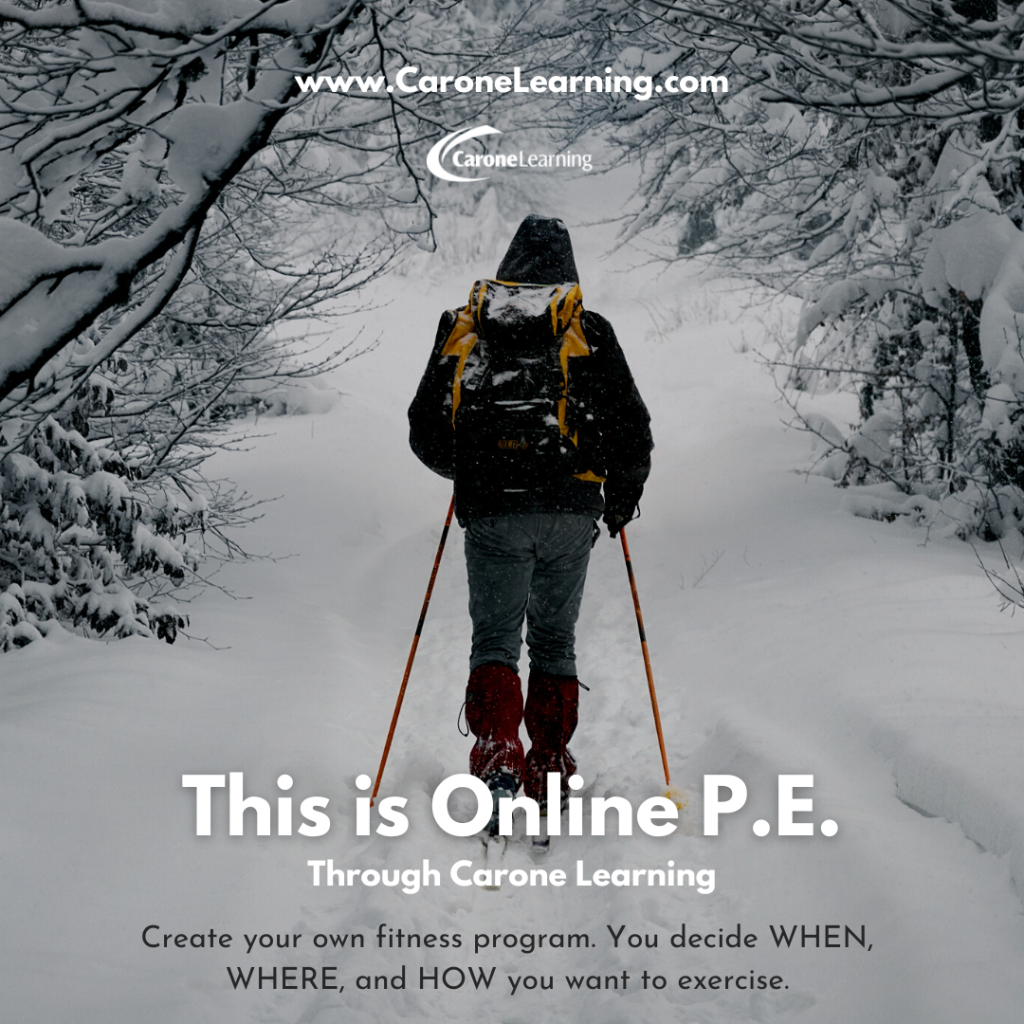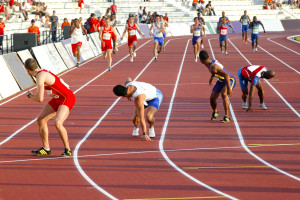
Category: Physical Education
Online vs Traditional Health & P.E.

A lot of people may doubt the effectiveness of online physical education. Can students really learn what they need to learn? Do students really gain the long-term benefits of a health and fitness education?
THE STUDY
A researcher from the University of Tampa reached out to Carone Learning asking if we’d be willing to participate in a research study comparing the perceptions of students in traditional/ face-to-face health and PE classes with those of our online students at our Carone Learning Academy.
The researcher independently collected course evaluation data from our online students as well as students at a traditional/ face-to-face school. And what were the results? See for yourself:
(The following is taken from the Jan 2020 published study abstract. You can find the full peer-reviewed journal article here.)
RESULTS
The online education setting was found to be statistically significantly more favorable for students in terms of the feedback and responsiveness of the teacher, understanding and interest of the content and perceived positive health changes during the course. The qualitative findings on student perceptions were relatively consistent between both the online and F2F classes.
CONCLUSIONS
The results indicate that students’ positive perceptions in an online high school class may equal or surpass those in a traditional F2F format. Increasingly, youth are exhibiting enhanced capacity for online‐based coursework.
The main goals of health and physical education, whether face-to-face or online, are to help students understand the value of a healthy lifestyle and being physically active, as well as to establish positive health habits and a program of health-enhancing exercise.
Our online students, in particular, rated highly in these areas. They increased their knowledge of health and fitness, found value in being healthy, established regular habits, and indicated that they planned to continue even after class was over. We consider that a win!
Why Online PE?
High school students these days are often turning to online l earning to help them get the credit they need for graduation. Online math, science, and language arts are now considered mainstream, but what about PE? Is there a need for online PE? Why are students turning to an online physical education solution?
earning to help them get the credit they need for graduation. Online math, science, and language arts are now considered mainstream, but what about PE? Is there a need for online PE? Why are students turning to an online physical education solution?
Three Reasons Why Students Take Online PE
1. Need for a flexible schedule.
One of the most common reasons students take an online course is the need for a flexible schedule. Oftentimes students want to take additional elective courses during the school day—foreign language, band, choir, drama, wood shop—there’s too many good options! Taking online PE or health classes frees up a period so students can take an additional class of their choice.
Additionally, students want the flexibility to take the course how, when, and where they want. Online learning provides that anytime, anywhere flexibility. We often work with students who have limited schedules because they are training for the Olympics, traveling concert pianists, or focusing early on a career. However, this need for flexibility is also seen as a major factor for almost every student we have—whether they are a premiere athlete or a struggling teen. Online learning provides the freedom for students to work on classes at their own pace and however they see fit.
2. Don’t want to exercise at school.
There’s a variety of reasons a student may not want to attend gym class at school. For one thing, the locker room scene can be an uncomfortable situation. Plus, having to change your clothes, shower, and redo your make up or hair in a matter of minutes is less than ideal. Getting hot and sweaty in the middle of the school day is not generally something to look forward to. So many students opt to keep their clothes on during school and take an online PE class where they can choose to exercise at a time that is more convenient to them.
3. Setting the stage for life long fitness.
Although there are certainly some great in-school physical education programs out there, more often than not, they focus on playing group sports and learning the rules of the game. Yes, these are great skills to have, but how well do they set a student up for life long fitness? What are the life management and personal fitness skills a student needs to have to help them be healthy and fit for the rest of their lives? Because of the personal nature of online learning, a virtual environment is actually an ideal setting for learning about personal health and fitness. Students learn principles about health and fitness and practice applying those principles to their own lives and workouts.
Although online learning may not be for everyone, there’s a variety of reasons an online PE course is the perfect fit for many students. Carone Learning is the premiere provider of online PE and health courses. Learn more today!
How Do Olympic Athletes Keep Getting Better?
 Last August we all watched in awe at the XXXI Olympiad in Rio. As Katie Ledecky once again broke the world record for the 800 meter freestyle, we couldn’t help but wonder: how do we keep getting faster? 100 years ago, the world record for women’s 800 meter freestyle was 13 minutes. Last August, Katie Ledecky shaved about 5 minutes off of that time.
Last August we all watched in awe at the XXXI Olympiad in Rio. As Katie Ledecky once again broke the world record for the 800 meter freestyle, we couldn’t help but wonder: how do we keep getting faster? 100 years ago, the world record for women’s 800 meter freestyle was 13 minutes. Last August, Katie Ledecky shaved about 5 minutes off of that time.
In his TED talk, David Epstein shed a lot of light on this phenomenon. He argued that it’s not humans that are evolving. Rather, it’s the games themselves.
Huge Leaps Forward
Epstein shares a graph that illustrates huge leaps and bounds in swim times throughout the years. He correlated those to new developments in methodology, tech, and engineering. For example, when the flip turn was incorporated into swim races, it cut off a significant amount of time in the world record. Additionally, new developments in swimwear allow swimmers to cut through the water and move more effectively.
Wider Access Makes the Field More Competitive
One major reason for the growth and development of athletes in general is the way that access to the sporting world has grown hugely in the last hundred years. Today, athletes are professionals, not amateurs who train in their free time. Today, access to athletics is available for more women, for more races, and for more socioeconomic groups. Between that and the growing population, we have a much larger group from which to choose our best and brightest athletes. After all, who’s better: the best of 100 people, or the best of 5,000?
The Rio games this year illustrated this development dramatically with our American women. They absolutely dominated, and many attribute that to the wider access that women have to sports over other countries and locations.
Sports Psychology Teaches Us To Test the Boundaries
The final big reason for the constant improvement of our athletes is harder to put your finger on. It has to do with the mental limitations that we put on ourselves. This was most dramatically and memorably illustrated by the shattering of the four minute mile. In 1945, the world record for running a mile was held by Gunder Hagg, who completed it in 4 minutes and 1.3 seconds. For almost 10 years, it was believed that humans had gone as far as they could go; there was no way to conquer a mile in less than four minutes.
It could be due to this psychological barrier that so many people made it their goal to defeat the four minute mile. In 1954, Roger Bannister completed a mile in 3 minutes and 59.4 seconds. Only two months later, another athlete broke this barrier, Australian John Landy. Since then, the four minute mile is the standard for world-class runners, although it’s left the common vernacular since sports shifted to the metric system.
However, this incident illustrates an interesting point: sometimes, the biggest barrier to achievement is psychological. Sports psychologists work with athletes to help them push the boundaries of the human body. Any marathon runner will say that the race is just as much a mental feat as a physical one.
Exercise Science
For those fascinated (as we are) with the amazing feats of the human body, as demonstrated through Olympic athleticism, Exercise Science may be an optimal field of study to pursue. To get you on the right track, Carone Learning’s Exercise Science course covers aspects from the physiology of body systems and analyzing biomechanics to sports psychology and nutrition. Learn more today!
PE for Students with Physical Limitations
 Many traditional schools offer waivers in PE so that students with physical limitations will not have to take PE courses. However, that is really doing a dis-service to the student. Rather than opting out of PE, students should still have the opportunity to learn about health and fitness principles and participate in physical activity (if able) at their own pace and level. Schools should offer these students an alternate option.
Many traditional schools offer waivers in PE so that students with physical limitations will not have to take PE courses. However, that is really doing a dis-service to the student. Rather than opting out of PE, students should still have the opportunity to learn about health and fitness principles and participate in physical activity (if able) at their own pace and level. Schools should offer these students an alternate option.
Online education is an excellent option for students with physical limitations because course requirements can easily be adapted to meet a student’s abilities. Students will still learn vital fitness principles, and they can work on progressing in areas where they are able. Carone Learning offers an adaptive PE course specifically for students with limitations, and we can also adapt the requirements of many of our online courses to meet special needs. Continue reading “PE for Students with Physical Limitations”
What Does a Fully-Rounded Education Look Like?
 An effective education is so much more than grammar and algebra. Education is meant to prepare children for the future challenges that they’ll confront in their lives. In such a rapidly-shifting world, it can be hard to know exactly what will be useful to students in the future. Children need to be flexible, lifelong learners. That’s why modern educators are calling for a shift that in our system that educates the whole child. Continue reading “What Does a Fully-Rounded Education Look Like?”
An effective education is so much more than grammar and algebra. Education is meant to prepare children for the future challenges that they’ll confront in their lives. In such a rapidly-shifting world, it can be hard to know exactly what will be useful to students in the future. Children need to be flexible, lifelong learners. That’s why modern educators are calling for a shift that in our system that educates the whole child. Continue reading “What Does a Fully-Rounded Education Look Like?”
PE: The Solution to America’s Health Crisis?
 Unless you’ve been living under a rock for the last couple of decades, you are well aware that America is having a health crisis. Every year, our nation pays $320 billion to treat cardiovascular disease and stroke. Every year, we pay $300 billion to treat Type 2 Diabetes. While the causes of these diseases are diverse and can’t just be limited to one thing, the vast majority of these cases could be treated, mitigated, and even prevented with proper diet and exercise.
Unless you’ve been living under a rock for the last couple of decades, you are well aware that America is having a health crisis. Every year, our nation pays $320 billion to treat cardiovascular disease and stroke. Every year, we pay $300 billion to treat Type 2 Diabetes. While the causes of these diseases are diverse and can’t just be limited to one thing, the vast majority of these cases could be treated, mitigated, and even prevented with proper diet and exercise.
Inactivity has been called the new epidemic. In fact, some studies show that a sedentary lifestyle is even more damaging to your health than smoking. More people die each year from health effects of a lack of movement and exercise than do from the many health problems caused by smoking.
What’s the Fix?
The problems has gotten out of control, and it’s hard to see how we can make changes as adults who are already confronting these health problems.
However, we should be able to find a solution for our children.
Obesity among children has doubled in the last 20 years, and among adolescents, it’s tripled. 80% of the children in the US are at risk for health problems that are related to inactivity. And yet, there’s never been a time in our history when we’ve put less priority on the solution!
Physical Education Is at an All-Time Low
The U.S. Department of Health and Human Services recommends that youth and teens participate in at least 60 minutes of daily physical activity. According to the CDC, only 29% of high school students receive daily physical education. Each year we are seeing numbers drop more and more when it comes to the number of children and youth who are involved in physical activities in and outside of school.
In an attempt to cut education budgets, many schools have dropped PE altogether. Even schools who still have physical education programs are getting by with less than $1000 a year budgeted. To make matters even worse, many schools are cutting back on, and even eliminating, recess, arguing that this leaves more time and resources for academic work. It’s obvious that even though physical activity has been proven to improve academic performance, it’s being given shamefully low priority in our public schools.
Benefits of Exercise
Just in case we need to enumerate the many benefits of exercise, here’s a list:
- Exercise – even a minimal amount – greatly reduces your risk of diverse health problems; cancer, diabetes, and cardiovascular disease, and also things we don’t hear about as often, like vision problems and gum disease.
- Exercise boosts mood and can even counter severe mental illness like depression and schizophrenia.
- Exercise leads to better interpersonal skills among children, making for healthier communities and more opportunities for that child in the future.
Physical Education Benefits Individuals for Life
The real question, perhaps, is whether physical education actually has a positive impact on habits and lifestyle beyond the classroom (or gym or field). The answer is yes! Adults who had PE classes are twice as likely to live active lifestyles. A taste of the benefits of physical activity when we’re young will carry on into our lives as we grow. Even higher results are shown if a physical education program teachers principles about health and fitness and allows students to practice self-management skills. This is exactly the kind of program students can find at Carone Learning– PE that is personalized to their needs and interests where they learn the skills and principles they need to be successful for life.
If your child isn’t benefiting from a physical education program, they’re missing out. You can change that with Carone Learning. Check out our options for online physical education courses that can give your child a healthy foundation for a lifetime.
4 Signs Online Learning is for You
 With schedule constraints and a need for more personalized programs, it’s time for a new way to learn about health.
With schedule constraints and a need for more personalized programs, it’s time for a new way to learn about health.
Online learning is here to fill the gap. After all, modern technology enables us to create customizable solutions for health and physical education. At Carone Learning we teach in the way that most modern students learn best; using online media and guidance to enable self-motivated learning.
However, anyone who has taken an online course knows that it takes more than a username and password. It requires a certain degree of personal accountability, and an affinity for technology-enabled communication. Here are 4 signs that you (or your child) will be able to succeed with our online health, physical education, or career courses:
1: You Thrive with a Personalized Curriculum
Health and fitness are such personalized subjects, it’s difficult to use a one-size-fits-all model. Furthermore, negative social pressure in some schools can provide an atmosphere where it’s hard to succeed for many students. However, with online learning, you are able to create a well-rounded exercise program, explore your personal interests, and determine your level of social interaction in physical activity.
2: You’re a Self-Motivated Learner
You like to set your own goals, and explore things that you’re curious about. Most children start with this mindset. They love to learn, and are endlessly curious. However, squeezing students into standardized measures and methods can drain a child’s thirst for learning. Online learning can re-spark the love of learning, and the satisfaction in physical exertion that all of us naturally have. Paired with the support and resources that an accredited program can provide, many students succeed in online learning much better than they do in traditional programs.
3: Your School Schedule Is Cramped
Many online students participate in this way because the focus of their life makes traditional school schedules impractical. This might be due to:
- Health challenges
- Working ahead or behind
- Traveling and transitional periods
If your schedule requires flexibility, or your time or physical ability is limited, that doesn’t mean that you should miss out on the advantages of health or physical education, particularly when required for graduation. Taking an online class can provide the flexibility you need to meet the other demands of your school schedule and your life.
4: You’re Comfortable with Technology
Online learning will, of course, require a certain level of tech-savvy. You need to be able to interact with teachers and other students across a digital interface, including emailing, participating in online discussions, and downloading and uploading assignments or evaluation. If you know how to navigate your way around an online portal and stay organized using computer programs, online learning could be your perfect fit.
Still wondering if online learning is right for you? Take this quiz and see where you stand.
Skills from Online Courses Translate as Lifelong Learning
Health and PE are provide principles that should act as a foundation for continued practice and learning throughout your life. Through personalized learning, you can find what works best for you, and how to support your own health and fitness, even after the classes are over.
If you have more questions, contact us today. We can give you more information on our course catalog, and what a class structure will look like.
Set Healthy Back to School Habits
 A new school year is well underway and our kids are out there being busy and productive (…hopefully). As you are establishing a school time routine, it’s the perfect time to set some goals for both ourselves and our children. The way that your child eats, the amount of sleep that he or she gets, and whether or not there’s exercise incorporated into the day can all make a huge impact on your child’s performance in school, not to mention their health and happiness.
A new school year is well underway and our kids are out there being busy and productive (…hopefully). As you are establishing a school time routine, it’s the perfect time to set some goals for both ourselves and our children. The way that your child eats, the amount of sleep that he or she gets, and whether or not there’s exercise incorporated into the day can all make a huge impact on your child’s performance in school, not to mention their health and happiness.
Here are some tips for healthy habits to make the school year a success:
Prepare Healthy Lunches
This undertaking often consumes more time than we like to spend in the evening, but a healthy lunch can make a huge difference in your child’s day. Have your kid help you to pick healthy, appealing options, and take extra time to prepare or cook something exciting. It could be anything from leftover dinner to a fun and unique veggie salad.
Have Healthy Breakfast Options
One of the biggest ways that excess sugar sneaks into our diets is through our breakfast foods. This sets a pattern for the rest of the day, causing us to crave sugar to maintain our energy levels, when actually, healthy protein, whole grains, and fresh fruits and vegetables are usually the best way to go.
Start checking the sugar content for many common breakfast foods, like yogurt, granola bars, juice, and pastries. Just a glass of orange juice and a granola bar can exceed your child’s recommended sugar allowance for the entire day! Fortify your kids with oatmeal, omelettes, or fruit smoothies.
Incorporate Play and Physical Activity Into Their Day
Whether or not your child’s school has recess, or a physical education program, it’s up to you to encourage your child’s physical play time. The CDC recommends that children and adolescents get 60 minutes of physical activity every day. This can include sports, climbing, running, biking… just about anything. Physical activity helps your child focus and improves healthy brain development in addition to keeping them physically fit. If you don’t think that your child is getting the physical education that they need, take a look at our home-study courses. They’ll help your child get active, and get school credit at the same time.
Set Specific Bedtimes
In order to perform his or her best, your child needs a set amount of sleep each night. Even more than that, they need a steady pattern that their body can adjust to in order to promote better, more restful sleep. Set a specific bedtime for your kids, and don’t waver on it. Encourage them to finish homework long before that time so that you can maintain a steady pattern.
We know all of this is easier said than done. But, as they say, nothing worth doing is really easy. Set an example for your children by prioritizing health and wellness this year.
Physical Activity Contributes to Better Grades
 Over the last couple of decades, budget cuts have hit our physical education classes in public schools hard. The idea is that cutting these programs will leave more time for academic studies, and therefore, improve test scores.
Over the last couple of decades, budget cuts have hit our physical education classes in public schools hard. The idea is that cutting these programs will leave more time for academic studies, and therefore, improve test scores.
Unfortunately, this short-sighted practice has had the opposite effect. It’s crippling our students; not only physically, but also academically.
Evidence Shows that Activity is Beneficial to Grades
The fact that exercise improves health isn’t something most people bother disputing. It’s obvious that physical activity protects against common health problems plaguing Americans: anything from high blood pressure to gum disease. However, an oft-overlooked benefit of exercise is its ability to improve cognition. Here are a few select examples from a large body of academic and professional studies that show the mental benefits of exercise for students:
- Think your child is fine because he or she isn’t overweight? Well, they could still be at a disadvantage from lack of physical activity. A study published in the Journal of American Pediatrics in August of 2013 tested children on both fitness tests and academic standardized tests. It was found that regardless of size, those who scored higher in fitness also scored higher in academics.
- Elementary-aged children with a physical education program integrated into their classrooms scored significantly higher over a four-month period on tests measuring fluid intelligence.
- One study presented at the American College of Sports Medicine found that children who were given 10 minutes to run around before a test scored higher in said test than children who were told to sit quietly for 10 minutes beforehand.
- One study of after-school programs found that periods of sustained play could improve children’s ability to memorize information and block out distractions while learning.
- A study at Dartmouth, published in Frontiers of Psychology in June 2014 found that it only took 12 minutes of exercise for children to improve in reading comprehension and visual focus.
Increasing a student’s physical activity isn’t just good for health, it’s good for grades! Schools and parents that understand these principles and support physical education and fitness programs will be more apt to see positive results in a students physical, mental, and academic well being.



